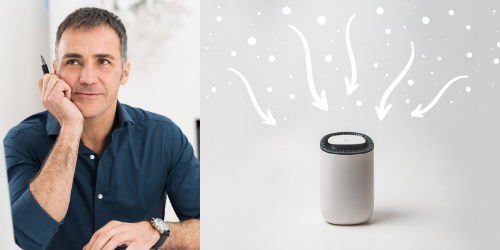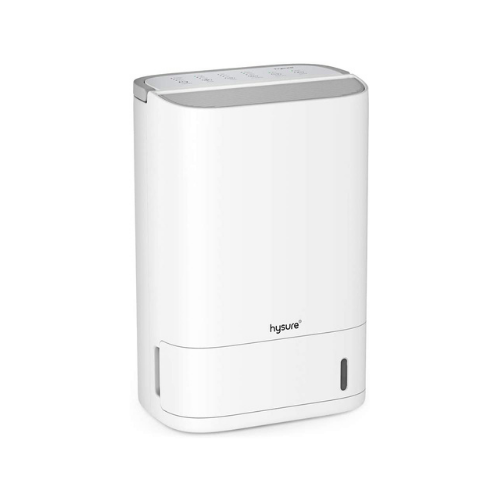Why does my dehumidifier freeze up?
3 Key Takeaways:
🚀 Dehumidifiers freeze up when the water vapor in the air condenses and freezes on the cold coils of the unit.
🚀 Temperature and airflow are two common reasons to inspect when a dehumidifier is icing up.
🚀 Blocked airflow is another overlooked reason that brings about dehumidifier freezing up.
Dehumidifiers help in maintaining the perfect humidity by drawing out the excess moisture content from the air and. But, sometimes the dehumidifiers can cause issues and does not work properly.
Most often when experts open up a dehumidifier to fix it, frozen coils are the common issue. Let us know more about why does a dehumidifier freeze up and how could one prevent the appliance from freezing.
What does it mean when a dehumidifier freezes up?

If you do not maintain your dehumidifier in the ideal conditions, it is common that your device builds ice and freezes up. Before we head to understand why a dehumidifier is freezing and how can one repair it, let us run through quickly over the dehumidifier’s functioning. A typical dehumidifier unit consists of cold evaporator coils, warm condenser coils, a fan, and a reservoir or drain.
Every dehumidifier model that has been making recent moves into the market also has a humidistat. A humidistat is similar in function to a thermostat. This will read the humidity level in the room and run the dehumidifier cycles accordingly. You will have the option of setting the humidistat to carry out humidity control to suit your comfort.
The unit of dehumidifier will pull in the hot humid air into the system through its vents. This humid air will travel through the unit’s cold evaporator coil. The air contacts the coil, and it condenses the air into water droplets in return. These water droplets will either be collected in the reservoir or will be drained out directly (depending on the model and your preference).
If your dehumidifier is not functioning correctly and is icing u, these water droplets will not reach the reservoir, rather they will generate a cold breeze. When the room temperature sies, the ice will melt, and the reservoir will overflow. A sign that your dehumidifier is in need of repair.
There are two common reasons to one will have to inspect when a dehumidifier is icing up.
Temperature and Airflow.
When there is a problem with temperature and unit air flow system, your dehumidifier will not work properly, it will lead to ice building up in its coils and you even any other form of serious damage. Let us see how temperatures and airflow can have an impact on dehumidifiers.
a. Temperature
When there is a dehumidifier that is freezing up, as the first step one could look into the temperature of the room. For dehumidifiers to function without any hiccups, it is important to keep temperature as under control. Maintaining the room temperature at 65 degrees F or higher will ensure that the device is able to carry out its job seamlessly. At lower temperatures, the water vapour will freeze instead of condensing; which leads to icing around the evaporator coils. When the steam from the water vapour causes icing, the air flow is blocked and the dehumidifier’s performance is hindered.
b. Air Flow
Air flow that is blocked is another overlooked reason that brings about dehumidifier freezing up. Condenser coils that are chocked up or a fan in need of repair can be the reasons why air flow is affected. Keeping a check on the fan, its fins, removing any dust or debris cover over the fins, maintaining the condenser coils, ordering out a replace of coils if necessary, etc., are some measures that will prevent huge damage to your dehumidifier in the long run.
Is it normal for a dehumidifier to ice up?
When the ideal temperatures are not maintained in the room or when there is impending repair in the unit related to filters, evaporator coils, condenser coils, air flow issues, power concerns, problems with defrost mode, etc., it is possible that ice will form inside the dehumidifier. However, it is not good for the unit since it will strain the motor, making it use more power than usual. A dehumidifier that is free of ice works best. It is important to inspect the device at regular intervals to make sure all parts, especially the metal ones, are free from ice build-up, and replace whatever parts have to be.
How to repair a dehumidifier with coils that are icing up?

If you happen to find that your dehumidifier is not carrying out any humidity control because of the coils icing up, here is what you could check into to fix the issue.
1. Blower wheel or Fan blade
In order to prevent frost from building up or freezing, there must be a sufficient amount of air blowing in and out of the dehumidifier’s evaporator coil and condenser coils. If you have made sure that the filter is clean, yet there is no air coming out through the grille area, it is then time to remove the cover and check the fan area.
The blower wheel and the fan blade are responsible to prevent freezing and manage the air flow. Gently brush off dust, debris, dirt, or any other particle that is preventing the fan area from doing its function. If the blower wheel or fan blade is damaged, you might want to replace them before running the appliance again. A dirty filter or fan area is not just unhealthy, but also a trouble to the unit.
2. Humidity Management System
Humidistat, which functions as a thermostat, also needs to be checked into if the coils in a dehumidifier are freezing. The humidistat carries out the function of tracking the humidity in the room; the electric contacts of the humidistat are designed to turn on the device’s compressor. If the humidistat is not working, the compressor will also malfunction and promote coil freezing. Simultaneously, the electric contacts of the humidistat could get fused shut. Disconnect the dehumidifier from the power source and have an expert look into the electric contacts of the humidistat and get them fixed.
3. Fan Motor
As aforementioned, the fan is important to regulate seamless flow of air in and out of the device. Check if the fan motor is working correctly by noticing the airflow from the grille area. A faulty fan motor means faulty fan; which indirectly leads to a device that could freeze. You will be able to judge the fan motor function by listening for the sound and for the speed. If there is a problem with the fan motor, both of these factors will reflect the issue.
Two best Dehumidifiers for low temperature
Our suggestion for the best dehumidifiers that work perfectly fine even at low temperatures are:
1. HomeLabs 4500 Square Feet Dehumidifier
Homelabs dehumidifier is the most popular and efficient model which offers powerful humidity control and packed with advanced features for easy user operation. This is the most capable model for moisture removal and perfectly designed for modern homes. This portable dehumidifier reduces odors and moisture through its built-in pump compressor. Its operating temperature range is 41°F to 95°F which means you can remove excess humidity even in the winter using homelabs dehumidifier. Do not miss this best selling dehumidifier for home. Click below to check the current price for homelabs dehumidifier.
2. Hysure Basement dehumidifier
Another dehumidifier for low temperature operation for medium to large basements is Hysure Dehumidifier. This desiccant dehumidifier removes 15 pints of water per day at temperature as low as 23°F which is ideal for basements, office, home, bathroom, bedroom, kitchen, stockroom, living room, laundry room, cellars, crawlspace and any rooms up to 430 sq ft. Do take a look at this quiet dehumidifier with washable filter if you are looking for a budget friendly lightweight yet powerful dehumidifier.
FAQ Section
1. What should I set my dehumidifier to in the winter?
It is recommended that you reduce dehumidifier use in winters, as the humidity will drop when it gets cold or when a heater is in use within the home. You can set your unit at 60% or below when the temperature drops. A good range would be 45% to 50%. A comfortable setting would be 30% to 60%.
2. How do I know if my dehumidifier compressor is bad?
If you have verified that the ambient room temperature is above 65 degrees Fahrenheit, but still the device is unable to pull water from the air; it means you are dealing with a faulty compressor. The overload device in the compressor circuit might be damaged, causing the compressor to also fail.
3. Can a dehumidifier be stored in freezing temperatures?
Yes, a dehumidifier can be stored at low temperatures, but it comes with its own set of challenges. Any water left in the pump or drain tube will be frozen, leading to subsequent unit damage.
4. What is the minimum temperature for a dehumidifier to work?
It has been advised that most models of dehumidifiers should not be operated at temperatures below 60° F because moisture removed from the indoor air can freeze when it condenses on the cooling coils.
5. Will a dehumidifier work in a cold room?
Dehumidifiers work better at normal room temperatures. Be it your kitchen or basement, colder weather is ticky for a dehumidifier to handle. If you expect cold weather all year round; it is advised that you look out for models that are designed to withstand harsh climate specifically.
6. How do you defrost a dehumidifier?
Most dehumidifier models that are now available in the market have their own Auto Defrost feature. Apart from that, one can elevate the device and expose the unit to higher temperatures to initiate the ice to melt.
Wrapping Up
Ready to fix the dehumidifier now?
Also, Don’t forget to read the instruction manual to help you with additional tips and images on fixing the unit. Check out our website for dehumidifiers reviews and ratings, air quality information, and tips.

